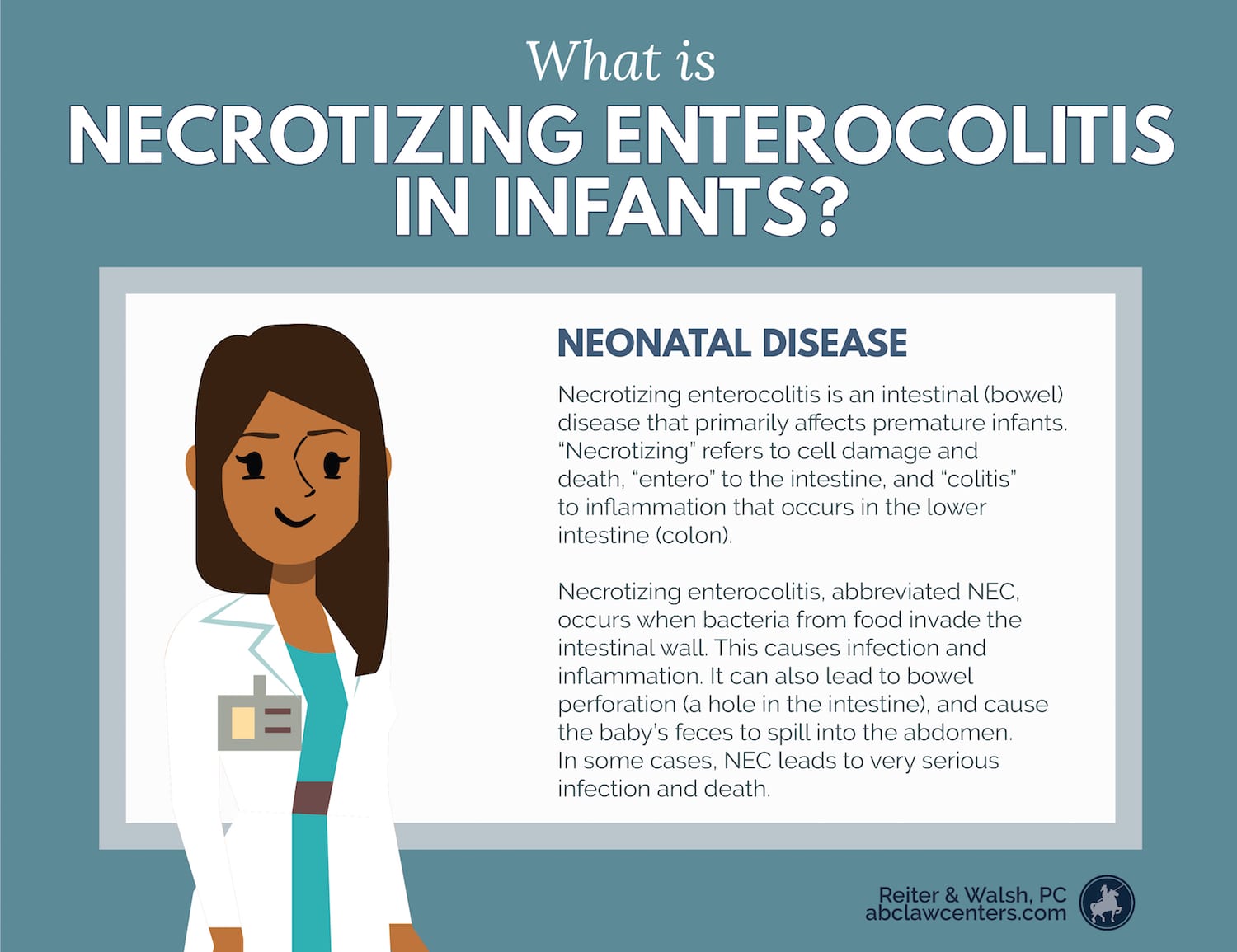Necrotizing Enterocolitis (NEC)
Necrotizing enterocolitis is an intestinal (bowel) disease that primarily affects premature infants (1). “Necrotizing” refers to cell damage and death, “entero” to the intestine, and “colitis” to inflammation that occurs in the lower intestine (colon) (2).
Necrotizing enterocolitis, abbreviated NEC, occurs when bacteria from food invade the intestinal wall. This causes infection and inflammation. It can also lead to bowel perforation (a hole in the intestine), and cause the baby’s feces to spill into the abdomen. In some cases, NEC leads to very serious infection and death (1, 2).

Incidence of necrotizing enterocolitis
Overall, necrotizing enterocolitis is fairly rare, affecting approximately one in 2,000 to 4,000 births. However, among babies in the neonatal intensive care unit (NICU), it is more common. An estimated 1-5% of babies in the NICU suffer from NEC (1). It is most common in babies that weigh less 1500 grams (this is considered very low birth weight, or VLBW) (2).
Risk factors and causes of necrotizing enterocolitis
NEC most commonly occurs in premature infants. Preemies often have insufficient circulation of oxygenated blood (because their lungs and other organs are underdeveloped). This is particularly true when they are deprived of oxygen around the time of birth. This impaired circulation can damage the lining of the intestinal wall, which increases the risk of infection and intestinal perforation (1).
Moreover, premature babies’ digestive and immune systems are inefficient, further increasing their susceptibility to NEC.
Additional risk factors for NEC include the following:
- Formula feeding
- A difficult delivery
- Birth asphyxia (when a baby is deprived of oxygen during or around the time of birth)
- Too many red blood cells
- Gastrointestinal infections (2)
Prevention of necrotizing enterocolitis
Because prematurity is such an important risk factor, steps taken to prevent premature birth can also prevent the development of NEC. It is also critical that medical professionals do everything in their power to prevent birth asphyxia and other delivery complications.
If premature birth is very likely, doctors may recommend that the mother be injected with a corticosteroid called betamethasone. Betamethasone can speed up development of the baby’s organs and tissues, which decreases vulnerability to necrotizing enterocolitis, as well as a variety of other complications and lifelong disabilities associated with premature birth (3, 4). Research has also shown that postnatal (after birth) treatment with steroids can improve outcomes for babies with NEC, although it may not reduce the incidence of this disease (3).

Signs and symptoms of necrotizing enterocolitis
NEC usually appears within an infant’s first two weeks of life. Signs and symptoms include the following:
- Inability to tolerate feedings
- Abdominal bloating/distention
- Vomiting bile (which appears green)
- Blood in stool
- Respiratory problems (apnea and bradycardia)
- Red, tender abdomen
- Diarrhea
- Lethargy
- Low blood pressure/shock (1)
Diagnosis of necrotizing enterocolitis
Diagnosis of NEC involves examining the baby for signs and symptoms (see above). Additionally, the following findings may be indicative of NEC:
Radiographic findings:
- Air bubbles in veins that travel to the liver
- Air in the abdominal cavity, outside of the intestines
Blood test findings:
- Low number of platelets
- Low number of white blood cells (1)
Finally, doctors may insert a needle into the abdominal cavity. If they withdraw intestinal fluid from the abdomen, this is a sign that there is a hole in the intestines (2).
Treating necrotizing enterocolitis
The appropriate treatment for NEC varies based on the individual baby’s circumstances. Doctors should take into account factors such as gestational age, seriousness of the disease, other medical complications, expected tolerance for certain medications and procedures, and the parents’ preferences (see our page on informed consent).
Doctors may recommend the following measures (among others):
- Stopping feedings
- Inserting an IV
- Inserting a nasogastric tube in order to keep the stomach empty
- Using antibiotics to treat the infection
- Conducting a series of X-rays to examine the progress
- Providing extra oxygen or assisted respiration
- Isolating the baby to prevent the spread of infection
In severe cases, babies with NEC may require surgery to remove the diseased portion of the intestine. Part of the intestine may also need to be connected to an ostomy, which is a surgically-created opening on the surface of the abdomen through which stool can exit into a pouch (2).
In the future, babies with NEC may also benefit from treatment with probiotics (which can replace “bad” bacteria with “good” bacteria) and/or very small quantities of carbon monoxide (which can inhibit the production of nitric oxide, a substance that causes destruction of the intestinal wall). Further research is needed on these possibilities (1).
Long-term outcomes of necrotizing enterocolitis
Prognoses for babies with NEC vary depending on the severity of the disease and quality of treatment. Many make a full recovery. However, others may develop long-term complications, such as the following:
- Intestinal scarring and narrowing, which can lead to blockages
- Inability of the intestines to adequately absorb nutrients
- Need for a bowel transplant (1)
Necrotizing enterocolitis and medical malpractice
Medical professionals have an obligation to recognize signs of NEC, and carefully manage infants with this condition as well as those who are at high risk of developing it (such as premature babies). If they fail to do everything they can to prevent NEC, and/or to provide proper treatment for a baby who already has NEC, this is negligence. If their negligence causes harm, it constitutes medical malpractice.
Do you have a case?
ABC Law Centers: Birth Injury Lawyers focuses exclusively on birth injury cases. Clients never pay any fee unless we win or favorably settle their case.
Sources
- Necrotizing Enterocolitis. (2018, May 20). Retrieved August 29, 2018, from https://www.chla.org/necrotizing-enterocolitis
- Default – Stanford Children’s Health. (n.d.). Retrieved August 29, 2018, from https://www.stanfordchildrens.org/en/topic/default?id=necrotizing-enterocolitis-90-P02388
- Halac, E., Halac, J., Bégué, E. F., Casañas, J. M., Indiveri, D. R., Petit, J. F., … & Obregón, R. J. (1990). Prenatal and postnatal corticosteroid therapy to prevent neonatal necrotizing enterocolitis: a controlled trial. The Journal of pediatrics, 117(1 Pt 1), 132-138.
- (n.d.). Retrieved September 5, 2018, from https://www.medscape.com/viewarticle/533480_9